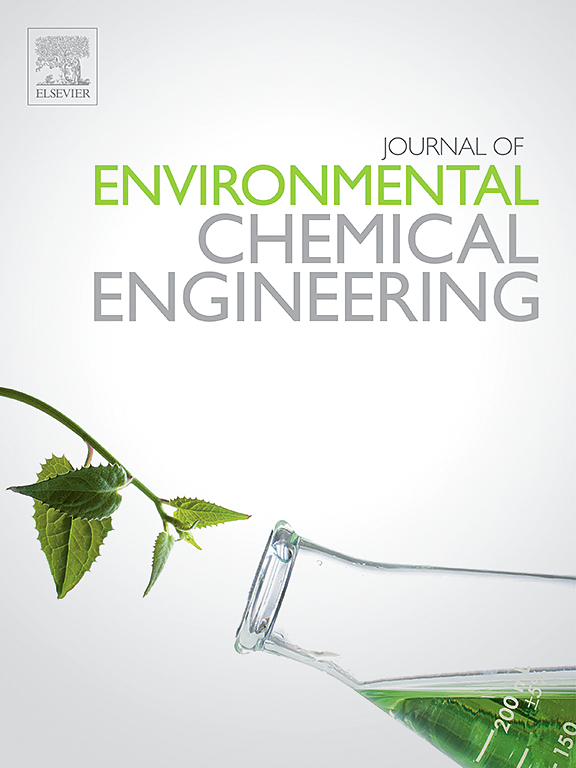Advanced biochar-based materials for specific antibiotics removal from hospital wastewater via adsorption and oxidative degradation
IF 7.4
2区 工程技术
Q1 ENGINEERING, CHEMICAL
引用次数: 0
Abstract
Antibiotics in hospital wastewater has become a critical issue due to their potential risks to human health and ecosystems. Biochar as a cost-effective and environmental-friendly carbon material has been employed for removing antibiotics. This article gives a holistic view of the properties of advanced biochar-based materials and clarifies mechanisms on removal of specific antibiotics from hospital wastewater. The increased pyrolysis temperature prepares the modified biochar with higher porosity and larger specific surface for enhancing adsorption. The metal-modified biochar possesses abundant functional groups, limits the leaching of metal ions, and increases the conductivity for improving activation of advanced oxidation process (AOP). Adsorption is significantly affected by the pyrolysis temperature, solution pH, and properties of modified biochar and antibiotics. The metal-modified biochar-assisted AOP can effectively degrade the pollutants via generating more reactive oxygen species. Weak acidic and/or weak alkaline condition promotes the degradation process in persulfate and peroxymonosulfate systems or during electrochemical oxidation process. Antibiotics removal at a wide pH range (3−11) can be achieved using Fenton-like and photo-Fenton systems with the presence of metal-modified biochar. Future research should focus on development of novel biochar with high reusability and great capability in removing a broad range of specific antibiotics.
通过吸附和氧化降解去除医院废水中特定抗生素的先进生物炭材料
医院废水中的抗生素对人类健康和生态系统具有潜在风险,因此已成为一个重要问题。生物炭作为一种具有成本效益且环保的碳材料,已被用于去除抗生素。本文全面介绍了先进生物炭基材料的特性,并阐明了去除医院废水中特定抗生素的机理。提高热解温度可使改性生物炭具有更高的孔隙率和更大的比表面,从而增强吸附性。金属改性生物炭具有丰富的官能团,限制了金属离子的浸出,并增加了电导率,从而改善了高级氧化过程(AOP)的活化。热解温度、溶液 pH 值以及改性生物炭和抗生素的特性对吸附有很大影响。金属改性生物炭辅助的 AOP 可通过产生更多活性氧来有效降解污染物。弱酸性和/或弱碱性条件可促进过硫酸盐和过一硫酸盐体系或电化学氧化过程中的降解过程。在广泛的 pH 值范围(3-11)内,使用类 Fenton 和光 Fenton 系统以及金属改性生物炭可以实现抗生素的去除。未来的研究重点应放在开发具有高重复利用率和去除多种特定抗生素能力的新型生物炭上。
本文章由计算机程序翻译,如有差异,请以英文原文为准。
求助全文
约1分钟内获得全文
求助全文
来源期刊

Journal of Environmental Chemical Engineering
Environmental Science-Pollution
CiteScore
11.40
自引率
6.50%
发文量
2017
审稿时长
27 days
期刊介绍:
The Journal of Environmental Chemical Engineering (JECE) serves as a platform for the dissemination of original and innovative research focusing on the advancement of environmentally-friendly, sustainable technologies. JECE emphasizes the transition towards a carbon-neutral circular economy and a self-sufficient bio-based economy. Topics covered include soil, water, wastewater, and air decontamination; pollution monitoring, prevention, and control; advanced analytics, sensors, impact and risk assessment methodologies in environmental chemical engineering; resource recovery (water, nutrients, materials, energy); industrial ecology; valorization of waste streams; waste management (including e-waste); climate-water-energy-food nexus; novel materials for environmental, chemical, and energy applications; sustainability and environmental safety; water digitalization, water data science, and machine learning; process integration and intensification; recent developments in green chemistry for synthesis, catalysis, and energy; and original research on contaminants of emerging concern, persistent chemicals, and priority substances, including microplastics, nanoplastics, nanomaterials, micropollutants, antimicrobial resistance genes, and emerging pathogens (viruses, bacteria, parasites) of environmental significance.
 求助内容:
求助内容: 应助结果提醒方式:
应助结果提醒方式:


